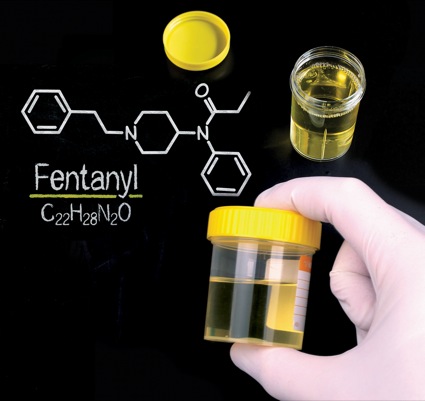Urine drug tests (UDTs) for cocaine use are showing a significant increase in positive results for nonprescribed fentanyl, according to a cross-sectional study of test results for a nearly five-year period.
In a sampling of 1 million UDT specimens, verified nonprescribed fentanyl among the cocaine-positive samples rose from 0.9% in 2013 to 17.6% in 2018, for an increase of 1,850%.
Although not as dramatic, positivity rates for nonprescribed fentanyl in the methamphetamine-positive group also increased significantly during the same time period, from 0.9% to 7.9%, for a 798% increase.
Leah LaRue, PharmD, PMP, an associate director of clinical affairs at Millennium Health in San Diego, which funded the study, said it is conceivable that increases in such overdose deaths may not be due to cocaine and methamphetamine alone, but to concomitant use with fentanyl. “To better understand what is causing this rapid increase in overdose deaths, it is important to characterize the emerging combination of other illicit drugs with fentanyl, which elevates the risk of overdose,” she said.
The study, published in JAMA Network Open (2019;2[4]:e192851. doi: 10.1001/jamanetworkopen. 2019.2851) analyzed Millennium Health’s UDT database.
“In addition to the significant rise in overall positivity, one surprising aspect of the study was the rates with which positives were identified across numerous practice specialties, including pain management, primary care, substance use disorder treatment, behavioral health, and obstetrics and gynecology,” Dr. LaRue said. “A subanalysis of results by these practice specialties revealed positives for nonprescribed fentanyl and either cocaine or methamphetamine across all treatment specialties, suggesting use is likely possible in many care settings. Thus, these results have a broader impact for the health care community at large, rather than being limited to those practices treating substance use disorders.”
Dr. LaRue said even though it is paramount to focus efforts on mitigating the risk for overdose death associated with opioids, “the significant results identified by this study suggest that it is also important to use available surveillance methods, such as UDT data, to recognize current trends in other drug categories and areas to monitor for the future.”
Furthermore, “history has proven that certain drugs of abuse have a resurgence in use following years of decline due to a number of factors, such as availability and ‘generational forgetting,’ which may happen as younger users become less knowledgeable about adverse consequences associated with certain substances,” Dr. LaRue said. “Monitoring these trends will better equip clinicians, policymakers and public health agencies to focus resources on maximizing patient safety.”
The concomitant use of fentanyl and a stimulant poses a significant risk to public health because of a heightened risk for overdose, according to Dr. LaRue. “Therefore, clinicians and patients should be aware of the risk of intentional or inadvertent fentanyl exposure with stimulant use, and take necessary precautions.”
Individuals who use stimulants may benefit from access to overdose prevention strategies, such as the provision of the opioid overdose antidote naloxone.
“Public outreach efforts should include education on the risks associated with fentanyl exposure, knowingly or unknowingly, as evidence suggests that users of illicit substances can no longer be certain of drug makeup,” Dr. LaRue said.
Based on the study results, the authors are now evaluating regional differences, potential shifts from heroin to fentanyl use in combination with stimulants, and the potential combination of fentanyl with other drugs.
“We remain committed to employing available resources to study these trends and share this information in the public domain to better serve the families and communities impacted by substance abuse and associated overdoses and deaths,” Dr. LaRue said.
Steven Prakken, MD, the director of the Medical Pain Service at Duke University in Chapel Hill, N.C., is not surprised by the increased positivity rates for nonprescribed fentanyl in UDTs. “Illegal fentanyl really started showing up in 2014, and has since skyrocketed,” he said. “Fentanyl has become prevalent in heroin, increasingly so in cocaine, and even in marijuana in some places.”
The study did not mention that fentanyl costs less than cocaine or heroin. “Not only is fentanyl a cheaper entity, it is easier to transport, hide, and add or mix into another drug, so part of the increase is financially driven,” Dr. Prakken said.
Dr. Prakken noted that opioids have a stimulating effect on roughly 15% to 25% of the population, depending on the particular opioid. “Therefore, some people are probably getting stimulated with the fentanyl, in addition to the cocaine,” he said.
Depending on the mix and potency of the drug combination, “some people are going to be very stimulated on the cocaine in a classic kind of response, while somewhat sedated on the opioid,” Dr. Prakken said. “This will provide a person with a distinct and appreciated euphoria. But that assumes all mixes are the same. I believe it is hard, though, to know exactly all the dynamics behind this phenomenon in a way that is going to make it predictable or consistent.”
To reduce the rates of nonprescribed fentanyl use, harm reduction must continue, according to Dr. Prakken. “Part of that is as simple as distributing fentanyl testing kits into the community for substance users to use, so they know what they are actually taking,” he said. “It would also be helpful to increase the supply of naloxone kits in the community, plus offer more substance use treatment to help people in the first place.”
—Bob Kronemyer
Dr. LaRue is an employee of Millennium Health, which funded the study. Dr. Prakken reported no relevant financial disclosures.





